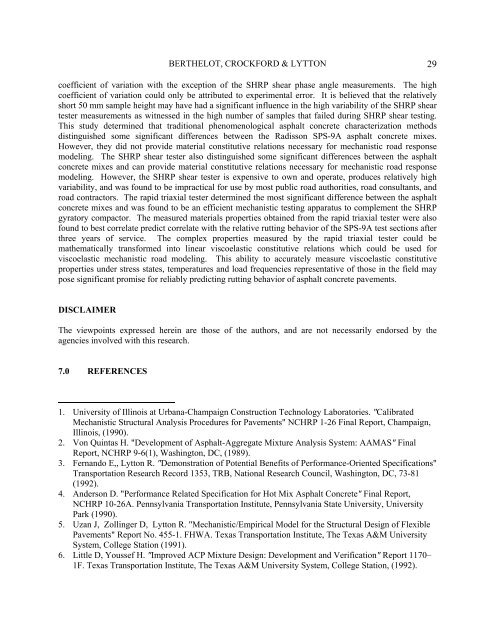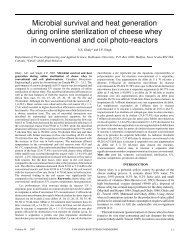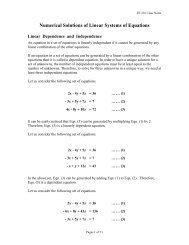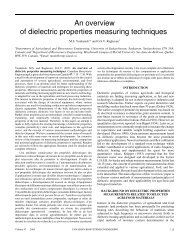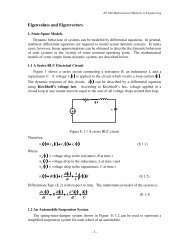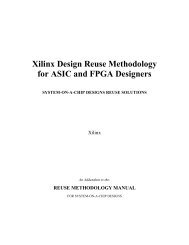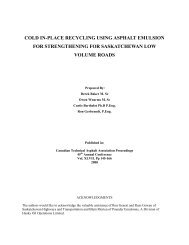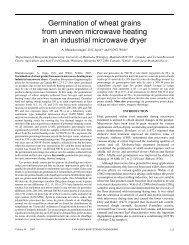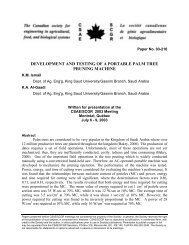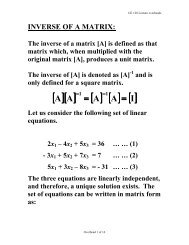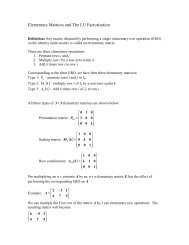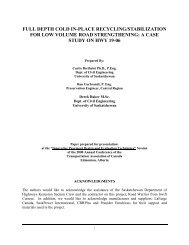BERTHELOT, CROCKFORD & LYTTON 29coefficient <strong>of</strong> variation with the exception <strong>of</strong> the SHRP shear phase angle measurements. The highcoefficient <strong>of</strong> variation could only be attributed to experimental error. It is believed that the relativelyshort 50 mm sample height may have had a significant influence in the high variability <strong>of</strong> the SHRP sheartester measurements as witnessed in the high number <strong>of</strong> samples that failed during SHRP shear testing.This study determined that traditional phenomenological <strong>asphalt</strong> <strong>concrete</strong> <strong>characterization</strong> methodsdistinguished some significant differences between the Radisson SPS-9A <strong>asphalt</strong> <strong>concrete</strong> mixes.However, they did not provide material constitutive relations necessary for mechanistic road responsemodeling. The SHRP shear tester also distinguished some significant differences between the <strong>asphalt</strong><strong>concrete</strong> mixes and can provide material constitutive relations necessary for mechanistic road responsemodeling. However, the SHRP shear tester is expensive to own and operate, produces relatively highvariability, and was found to be impractical for use by most public road authorities, road consultants, androad contractors. The rapid triaxial tester determined the most significant difference between the <strong>asphalt</strong><strong>concrete</strong> mixes and was found to be an efficient mechanistic testing apparatus to complement the SHRPgyratory compactor. The measured materials properties obtained from the rapid triaxial tester were als<strong>of</strong>ound to best correlate predict correlate with the relative <strong>rut</strong>ting behavior <strong>of</strong> the SPS-9A test sections afterthree years <strong>of</strong> service. The complex properties measured by the rapid triaxial tester could bemathematically transformed into linear viscoelastic constitutive relations which could be used forviscoelastic mechanistic road modeling. This ability to accurately measure viscoelastic constitutiveproperties under stress states, temperatures and load frequencies representative <strong>of</strong> those in the field maypose significant promise for reliably predicting <strong>rut</strong>ting behavior <strong>of</strong> <strong>asphalt</strong> <strong>concrete</strong> pavements.DISCLAIMERThe viewpoints expressed herein are those <strong>of</strong> the authors, and are not necessarily endorsed by theagencies involved with this research.7.0 REFERENCES1. University <strong>of</strong> Illinois at Urbana-Champaign Construction Technology Laboratories. "CalibratedMechanistic Structural Analysis Procedures for Pavements" NCHRP 1-26 Final Report, Champaign,Illinois, (1990).2. Von Quintas H. "Development <strong>of</strong> Asphalt-Aggregate Mixture Analysis System: AAMAS" FinalReport, NCHRP 9-6(1), Washington, DC, (1989).3. Fernando E,, Lytton R. "Demonstration <strong>of</strong> Potential Benefits <strong>of</strong> Performance-Oriented Specifications"Transportation Research Record 1353, TRB, National Research Council, Washington, DC, 73-81(1992).4. Anderson D. "Performance Related Specification for Hot Mix Asphalt Concrete" Final Report,NCHRP 10-26A. Pennsylvania Transportation Institute, Pennsylvania State University, UniversityPark (1990).5. Uzan J, Zollinger D, Lytton R. "Mechanistic/Empirical Model for the Structural Design <strong>of</strong> FlexiblePavements" Report No. 455-1. FHWA. Texas Transportation Institute, The Texas A&M UniversitySystem, College Station (1991).6. Little D, Youssef H. "Improved ACP Mixture Design: Development and Verification" Report 1170–1F. Texas Transportation Institute, The Texas A&M University System, College Station, (1992).
BERTHELOT, CROCKFORD & LYTTON 307. Lui M. "Numerical Prediction <strong>of</strong> Pavement Distresses with Geotechnical Constitutive Laws" Ph.D.dissertation. Texas A&M University, College Station (1993).8. Walker RN, Patterson WDO, Freeme CR, Marais CP. "The South African Mechanistic PavementDesign Procedure" Proceedings, Fourth International Conference on the Structural Design <strong>of</strong> AsphaltPavements, University <strong>of</strong> Michigan, 26-31 (1977).9. Maree JH Freeme CR. "The Mechanistic Design Method to Evaluate the Pavement Structures in theCatalogue <strong>of</strong> the Draft TR H4 1980" Technical Report RP/2/81. NITRR, Pretoria, South Africa, 59(1981).10. Freeme CR, Maree JH, Viljoen AW. "Mechanistic Design <strong>of</strong> Asphalt Pavements and VerificationUsing Heavy Vehicle Simulation" Proceedings, Fifth International Conference on the StructuralDesign <strong>of</strong> Asphalt Pavements, University <strong>of</strong> Michigan and Delft University <strong>of</strong> Technology156-173(1982).11. Brown SF, Pell PS, Stock AF. "The Application <strong>of</strong> Simplified, Fundamental Design Procedures forFlexible Pavements" Proceedings, Fourth International Conference on the Structural Design <strong>of</strong>Asphalt Pavements, University <strong>of</strong> Michigan, 227-241 (1977).12. Verstraeten J, Veverka V, Francken l. "Rational and Practical Designs <strong>of</strong> Asphalt Pavements toAvoid Cracking and Rutting" Proceedings, Fifth International Conference on the Structural Design <strong>of</strong>Asphalt Pavements, University <strong>of</strong> Michigan and Delft University <strong>of</strong> Technology 45-58 (1982).13. Thompson MR, Barenberg EJ. "Calibrated Mechanistic Structural Analysis Procedures forPavements: Phase I - Final Report". NCHRP Project 1-26, Transportation Research Board, NationalResearch Council, Washington, DC, March (1989).14. Monismith CL, Epps JA, Finn FN. "Improved Asphalt Mix Design" Proceedings, Association <strong>of</strong>Asphalt Paving Technologists 347-392 (1985).15. Whiffin AC, Lister NW. "The Application <strong>of</strong> Elastic Theory to Flexible Pavements" Proceedings,International Conference on the Structural Design <strong>of</strong> Asphalt Pavements, University <strong>of</strong> Michigan499-452 (1963).16. Skok EL, Finn FN. "Theoretical Concepts Applied to Asphalt Concrete Pavement Design"Proceedings, International Conference on the Structural Design <strong>of</strong> Asphalt Pavements, University <strong>of</strong>Michigan, 412-440 (1963).17. Peattie KR. "A Fundamental Approach to the Design <strong>of</strong> Flexible Pavements" Proceedings,International Conference on the Structural Design <strong>of</strong> Asphalt Pavements, University <strong>of</strong> Michigan403-411 (1963).18. Dormon GM. "The Extension to Practice <strong>of</strong> a Fundamental Procedure for the Design <strong>of</strong> AsphaltPavements" Proceedings, International Conference on the Structural Design <strong>of</strong> Asphalt Pavements,University <strong>of</strong> Michigan 785-793 (1963).19. Chua k, Lytton R. "A Method <strong>of</strong> Time Dependent Analysis Using Elastic Solutions for NonLinearMaterials" International Journal for Numerical and Analytical Methods in Geomechanics, 421-431(1987).20. Park S, Kim R, Schapery R. "A Viscoelastic Continuum Damage Model and Its Application toUniaxial Behavior <strong>of</strong> Asphalt Concrete" Mechanics <strong>of</strong> Materials, 241-255 (1996).21. Schapery R. "Models for Damage Growth and Fracture in Nonlinear Viscoelastic ParticulateComposites" Proceedings, Ninth U.S. National Congress <strong>of</strong> Applied Mechanics, New York, Book NoH00228, American Society <strong>of</strong> Mechanical Engineers (ASME) 237-245 (1984).22. Allen D. "Thermomechanical Coupling in Inelastic Solids" Applied Mechanics Rev., ASME 361-373 (1991).
- Page 1: COMPARISON OF ALTERNATIVE TEST METH
- Page 5 and 6: BERTHELOT, CROCKFORD & LYTTON 44.0
- Page 7 and 8: BERTHELOT, CROCKFORD & LYTTON 6not
- Page 9 and 10: BERTHELOT, CROCKFORD & LYTTON 8unco
- Page 11 and 12: BERTHELOT, CROCKFORD & LYTTON 10no
- Page 13 and 14: BERTHELOT, CROCKFORD & LYTTON 124.4
- Page 15 and 16: BERTHELOT, CROCKFORD & LYTTON 14Tab
- Page 17 and 18: BERTHELOT, CROCKFORD & LYTTON 16Tab
- Page 19 and 20: BERTHELOT, CROCKFORD & LYTTON 18Fig
- Page 21 and 22: BERTHELOT, CROCKFORD & LYTTON 20For
- Page 23 and 24: BERTHELOT, CROCKFORD & LYTTON 22Tab
- Page 25 and 26: BERTHELOT, CROCKFORD & LYTTON 24Tab
- Page 27 and 28: BERTHELOT, CROCKFORD & LYTTON 2650C
- Page 29: BERTHELOT, CROCKFORD & LYTTON 28Tab


